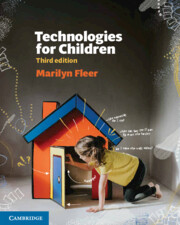273 results
About the author
-
- Book:
- Technologies for Children
- Published online:
- 11 July 2023
- Print publication:
- 10 July 2023, pp ix-ix
-
- Chapter
- Export citation
Chapter 3 - Designing and creating preferred futures
- from Part 1 - Researching technology and technologies education
-
- Book:
- Technologies for Children
- Published online:
- 11 July 2023
- Print publication:
- 10 July 2023, pp 71-90
-
- Chapter
- Export citation

Technologies for Children
-
- Published online:
- 11 July 2023
- Print publication:
- 10 July 2023
-
- Textbook
- Export citation
Chapter 9 - The curriculum in action: Project management
- from Part 2 - The curriculum in action
-
- Book:
- Technologies for Children
- Published online:
- 11 July 2023
- Print publication:
- 10 July 2023, pp 231-252
-
- Chapter
- Export citation
Chapter 10 - Planning, assessment and evaluation in technologies
- from Part 3 - Pedagogical practices for technologies
-
- Book:
- Technologies for Children
- Published online:
- 11 July 2023
- Print publication:
- 10 July 2023, pp 254-292
-
- Chapter
- Export citation
Part 1 - Researching technology and technologies education
-
- Book:
- Technologies for Children
- Published online:
- 11 July 2023
- Print publication:
- 10 July 2023, pp 1-118
-
- Chapter
- Export citation
Chapter 11 - Planning for teaching technologies: Analysing the pedagogical approaches
- from Part 3 - Pedagogical practices for technologies
-
- Book:
- Technologies for Children
- Published online:
- 11 July 2023
- Print publication:
- 10 July 2023, pp 293-306
-
- Chapter
- Export citation
Chapter 5 - The curriculum in action: Digital technologies in everyday life, the community and the classroom/centre
- from Part 2 - The curriculum in action
-
- Book:
- Technologies for Children
- Published online:
- 11 July 2023
- Print publication:
- 10 July 2023, pp 121-143
-
- Chapter
- Export citation
Chapter 6 - The curriculum in action: Digital technologies – computational thinking
- from Part 2 - The curriculum in action
-
- Book:
- Technologies for Children
- Published online:
- 11 July 2023
- Print publication:
- 10 July 2023, pp 144-171
-
- Chapter
- Export citation
Chapter 8 - Technologies contexts: Engineering principles and systems, and materials and technologies specialisations
- from Part 2 - The curriculum in action
-
- Book:
- Technologies for Children
- Published online:
- 11 July 2023
- Print publication:
- 10 July 2023, pp 201-230
-
- Chapter
- Export citation
Chapter 1 - What is technologies education?
- from Part 1 - Researching technology and technologies education
-
- Book:
- Technologies for Children
- Published online:
- 11 July 2023
- Print publication:
- 10 July 2023, pp 2-30
-
- Chapter
- Export citation
Contents
-
- Book:
- Technologies for Children
- Published online:
- 11 July 2023
- Print publication:
- 10 July 2023, pp v-viii
-
- Chapter
- Export citation
Copyright page
-
- Book:
- Technologies for Children
- Published online:
- 11 July 2023
- Print publication:
- 10 July 2023, pp iv-iv
-
- Chapter
- Export citation
Acknowledgements
-
- Book:
- Technologies for Children
- Published online:
- 11 July 2023
- Print publication:
- 10 July 2023, pp x-x
-
- Chapter
- Export citation
Chapter 7 - Technologies contexts: Food and fibre production and food specialisations
- from Part 2 - The curriculum in action
-
- Book:
- Technologies for Children
- Published online:
- 11 July 2023
- Print publication:
- 10 July 2023, pp 172-200
-
- Chapter
- Export citation
Acknowledgement of Country
-
- Book:
- Technologies for Children
- Published online:
- 11 July 2023
- Print publication:
- 10 July 2023, pp ii-ii
-
- Chapter
- Export citation
Index
-
- Book:
- Technologies for Children
- Published online:
- 11 July 2023
- Print publication:
- 10 July 2023, pp 318-324
-
- Chapter
- Export citation
References
-
- Book:
- Technologies for Children
- Published online:
- 11 July 2023
- Print publication:
- 10 July 2023, pp 307-317
-
- Chapter
- Export citation
Chapter 2 - Key ideas in the technologies curriculum
- from Part 1 - Researching technology and technologies education
-
- Book:
- Technologies for Children
- Published online:
- 11 July 2023
- Print publication:
- 10 July 2023, pp 31-70
-
- Chapter
- Export citation
Chapter 4 - Creativity in design
- from Part 1 - Researching technology and technologies education
-
- Book:
- Technologies for Children
- Published online:
- 11 July 2023
- Print publication:
- 10 July 2023, pp 91-118
-
- Chapter
- Export citation



